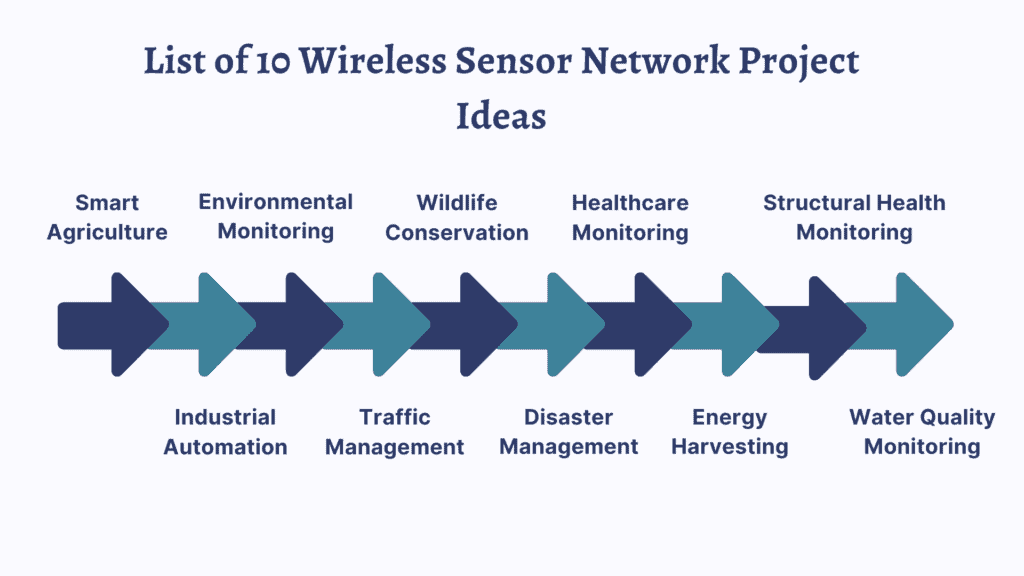Table of Contents
Key Takeaways
- Wireless sensor networks (WSNs) are a popular area of research and development, with numerous project ideas available for students and professionals.
- WSNs are composed of small, low-power devices called sensor nodes that can collect and transmit data wirelessly.
- One project idea is to develop a WSN for environmental monitoring, where sensor nodes can measure parameters such as temperature, humidity, and air quality.
- Another project idea is to create a WSN for smart agriculture, where sensor nodes can monitor soil moisture, temperature, and other factors to optimize crop growth.
- WSNs can also be used for structural health monitoring, where sensor nodes are deployed on buildings or bridges to detect any potential damage or structural weaknesses.
- Security is a crucial aspect of WSNs, and a project idea could involve developing secure communication protocols and encryption techniques to protect the data transmitted by the sensor nodes.
- Energy efficiency is another important consideration in WSNs, and a project idea could focus on developing energy harvesting techniques or optimizing the power consumption of the sensor nodes.
- Overall, WSN project ideas offer a wide range of opportunities for students and professionals to explore and contribute to the field of wireless sensor networks.

Wireless Sensor Networks are a revolutionary tech. They consist of small, autonomous sensors that communicate without wires to monitor the environment. They have huge potential for things like environmental monitoring, healthcare, agriculture, and smart cities.
An application of Wireless Sensor Networks is environmental monitoring. They can track parameters like temperature, humidity, air quality, and noise in real-time. This data can help researchers studying climate and city planners looking to improve life.
Another use of Wireless Sensor Networks is precision agriculture. Sensor nodes across a farm measure soil moisture levels, temperature, and other factors affecting crop growth. This helps farmers make decisions about irrigation and pest control, leading to more yield and less waste.
A great example of Wireless Sensor Networks is the story of a village with water scarcity during droughts. Engineers installed sensors across nearby water sources to measure water levels. This data was sent to a central server, allowing authorities to allocate water resources efficiently and ensure everyone had access to clean water. This project improved villagers’ livelihoods.
Wireless Sensor Networks have unlocked new opportunities for innovation and problem-solving. With their capability to collect data from various environments, they’ve become a must-have in many industries. They’re being used in environmental monitoring, healthcare like remote patient monitoring, and more.
Benefits of Wireless Sensor Networks
Wireless Sensor Networks (WSNs) are a must-have for many industries, thanks to their advantages. These include cost-effectiveness, flexibility, scalability, real-time monitoring, energy efficiency, and data accuracy.
Plus, WSNs provide extra benefits like seamless integration with existing systems, remote monitoring and control, and efficient disaster management.
A great example of WSNs in action is in the agricultural sector. Farmers are using them to monitor soil moisture levels in their fields. This gives them real-time data, allowing them to optimize irrigation schedules and maximize crop yields, all while conserving water.
Say goodbye to ‘no pain, no gain’ – with WSNs, setting up a project is a breeze!
Challenges in Wireless Sensor Network Projects

Wireless Sensor Network (WSN) projects come with a range of challenges. Limited power supply, deployment of numerous nodes in wide areas, and secure communication are some of these.
Power supply is a major issue, as sensors are powered by batteries. To conserve energy, efficient planning and resource allocation are necessary. Secure communication must be ensured, to prevent data breaches.
Interference from outside sources can disrupt the network. Faulty sensors may lead to inaccurate data collection.
Great progress has been made. For example, WSNs were used to monitor environmental conditions in a wildlife sanctuary. Sensor nodes collected real-time data on temperature, humidity, and animal movements. This data was invaluable for understanding and preserving the ecosystem.
Technology is improving, making it easier to overcome these challenges. Energy-efficient sensing devices and robust communication protocols are being developed. With research and innovation, WSNs have potential for many applications such as agriculture, healthcare, and environmental monitoring.
Explore the exciting world of WSN Project Ideas and discover the endless possibilities!
List of 10 Wireless Sensor Network Project Ideas

Wireless sensor networks are revolutionizing industries with real-time data collection and monitoring. They’ve changed agriculture, healthcare, traffic management, and environmental conservation. This article presents 10 fascinating project ideas that showcase the versatility of wireless sensor networks.
- Smart Agriculture: Intelligent system to monitor and control soil moisture, temperature, and humidity – optimizing crop yield and reducing water consumption.
- Environmental Monitoring: A sensor network to collect data on air quality, noise levels, temperature, and pollution in urban areas.
- Wildlife Conservation: A wireless sensor network to track animal movements, habits, and behavior patterns.
- Healthcare Monitoring: Wearable sensors to monitor vital signs like heart rate, blood pressure, and oxygen levels.
- Structural Health Monitoring: Sensors to assess the integrity of buildings, bridges, and highways – detecting fractures and vibrations.
- Industrial Automation: Sensor network to automate industrial processes, monitor equipment performance, and optimize energy consumption.
- Traffic Management: Smart traffic system using sensors to collect data on traffic flow, congestion levels, and accidents.
- Disaster Management: Wireless sensor network for early detection and response to natural disasters like earthquakes, floods, or wildfires.
- Energy Harvesting: Energy-efficient sensors that harvest energy from the environment (solar or kinetic) to power themselves.
- Water Quality Monitoring: Sensors in rivers or lakes to monitor pH levels, dissolved oxygen, and contaminants.
These project ideas demonstrate the potential of wireless sensors. As tech advances, the possibilities are endless! Wrapping up, this article may be ending, but the potential of wireless sensor networks is only just beginning.
Frequently Asked Questions
Q: What is a wireless sensor network?
A wireless sensor network is a network of small, low-cost devices called wireless sensors that are distributed across a geographical area to gather and transmit data wirelessly.
Q: What are some project ideas for wireless sensor networks?
- Environmental monitoring: Using wireless sensors to monitor air quality, temperature, humidity, and other environmental factors.
- Smart agriculture: Deploying wireless sensors to monitor soil moisture, crop health, and weather conditions to optimize agricultural practices.
- Home automation: Creating a smart home system by integrating wireless sensors for monitoring and controlling various devices and appliances.
- Industrial monitoring: Using wireless sensors to monitor equipment performance, detect faults, and improve maintenance processes in industries.
- Traffic management: Implementing wireless sensor networks to monitor and analyze traffic patterns, optimize signal timings, and improve road safety.
- Healthcare monitoring: Developing wireless sensor-based systems for remote patient monitoring, tracking vital signs, and detecting emergencies.
Q: What are the benefits of wireless sensor network projects?
- Cost-effectiveness: Wireless sensor networks are often more affordable compared to wired alternatives, making them accessible for various applications.
- Scalability: These networks can easily expand by adding or removing wireless sensors, allowing flexibility and adaptability to changing needs.
- Real-time data collection: Wireless sensor networks enable continuous data collection and transmission, providing up-to-date information for decision-making.
- Efficiency and automation: Through wireless sensor network projects, processes can be automated, leading to increased efficiency and reduced human intervention.
- Improved safety and security: Wireless sensors can be deployed for monitoring and early detection of potential hazards, enhancing safety and security measures.
Q: What skills are required for working on wireless sensor network projects?
Working on wireless sensor network projects may require skills in programming languages like C, C++, or Python, as well as knowledge of networking protocols and wireless communication technologies. Expertise in data analysis and interpretation can also be beneficial.
Q: How can I get started with a wireless sensor network project?
- Identify a specific application or problem you want to address with a wireless sensor network.
- Research and familiarize yourself with different types of wireless sensors and their capabilities.
- Choose the appropriate hardware and software components required for your project.
- Design and implement the necessary network infrastructure to support the wireless sensors.
- Develop the code or software for data collection, transmission, and analysis.
- Test and validate the system, making any necessary refinements.
Q: Are there any open-source platforms or resources available for wireless sensor network projects?
Yes, there are several open-source platforms and resources available for wireless sensor network projects. Some popular ones include TinyOS, Contiki, and OpenWSN. These platforms provide software libraries, protocols, and tools to simplify the development process and facilitate collaboration among researchers and developers.
How Can Wireless Sensor Networks Be Utilized in Snow Project Ideas?
Wireless sensor networks can revolutionize unexpected snow project ideas by enabling real-time monitoring of snow levels, density, and temperature. These networks can help in efficient snow removal, avalanche prediction, and winter sports safety. Additionally, they can aid in climate research and wildlife monitoring in snowy regions.
Conclusion
Wireless Sensor Network projects bring lots of thrilling possibilities. From ecology monitoring to healthcare, these projects reveal the power of this tech.
An exciting project concept is a smart agriculture system. Wireless sensors would measure soil moisture, temperature, and humidity. This could help farmers water their crops better and boost yield.
Another cool project notion is using wireless sensors in industry for predictive maintenance. By monitoring equipment and detecting issues, costly breakdowns can be prevented and effectiveness increased.
Also, wireless sensor networks can manage traffic. Sensors installed at intersections and roads can capture real-time data on traffic. This data can then be used to alter signal timings and ease congestion.
Plus, introducing wireless sensors into smart homes brings lots of automation and remote monitoring options. Sensors can pick up motion, temperature, and energy usage. This allows homeowners to control their appliances and save power.
Finally, wireless sensors can assist with wildlife conservation. When positioned in endangered species’ habitats, sensors can collect data on animal behavior, migration, and environment. This data can help protect vulnerable ecosystems.
References:
Wireless Sensor Network Project Ideas
Wireless Sensor Network Project Ideas
Also Read: